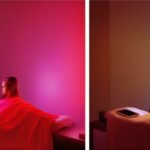In recent years, LED light therapy has become popular for its reported benefits in promoting skin rejuvenation, wound healing, and pain relief. Two popular forms of LED light therapy are infrared (IR) light therapy and red light therapy. While they may seem similar, it is important to understand the differences between these two forms of light therapy and whether they result in the same outcomes. In this discussion, we will explore whether infrared light therapy is the same as red light therapy, and if not, what are the primary differences between the two.
Contents
Understanding the Differences and Similarities
In recent years, light therapy has become a popular method for treating various health conditions, including pain, skin issues, and depression. Two common types of light therapy are infrared light therapy and red light therapy. While they share some similarities, there are also some significant differences.
What is Infrared Light Therapy?
Infrared light therapy uses a specific wavelength of light that penetrates deep into the body’s tissues, promoting healing and reducing pain. It is a non-invasive treatment that is often used for conditions such as arthritis, muscle strains, and joint pain. Infrared light therapy can also improve blood circulation, promote tissue repair, and reduce inflammation.
What is Red Light Therapy?
Red light therapy uses a different wavelength of light than infrared light therapy. It targets the surface of the skin and is often used for conditions such as acne, wrinkles, and other skin issues. Like infrared light therapy, red light therapy is a non-invasive treatment that is believed to promote healing and reduce pain.
The Differences Between Infrared and Red Light Therapy
While both types of light therapy are believed to have therapeutic benefits, there are some significant differences between them. Here are some of the key differences:
- Wavelength: Infrared light therapy uses a longer wavelength of light than red light therapy.
- Depth of Penetration: Infrared light therapy penetrates deeper into the body’s tissues than red light therapy.
- Applications: Infrared light therapy is often used for conditions such as arthritis and muscle strains, while red light therapy is typically used for skin issues like acne and wrinkles.
- Treatment Time: Infrared light therapy treatments are generally longer than red light therapy treatments.
The Similarities Between Infrared and Red Light Therapy
While there are some significant differences between infrared and red light therapy, there are also some similarities. Here are some of the key similarities:
- Non-Invasive: Both types of light therapy are non-invasive and do not require any incisions or injections.
- Pain Reduction: Both infrared and red light therapy are believed to reduce pain and promote healing.
- No Side Effects: Both types of light therapy are generally considered safe and do not have any significant side effects.
The Benefits of Infrared Light Therapy
Now that we understand the differences between infrared and red light therapy let’s take a closer look at the benefits of infrared light therapy.
Pain Reduction
Infrared light therapy is often used for pain reduction. It is believed to reduce inflammation and promote tissue repair, which can help to alleviate pain caused by conditions such as arthritis, muscle strains, and joint pain.
Improved Circulation
Infrared light therapy can also improve blood circulation. It does this by dilating blood vessels, allowing more oxygen and nutrients to reach the body’s tissues. Improved circulation can help to promote healing and reduce pain.
Tissue Repair
Infrared light therapy is believed to promote tissue repair. It does this by stimulating the production of collagen, which is an essential protein for skin and tissue repair. This can help to reduce the appearance of scars and promote the healing of wounds.
Skin Health
Infrared light therapy can also improve skin health. It does this by stimulating the production of elastin and collagen, which can help to reduce the appearance of wrinkles and fine lines. It can also improve skin tone and texture, making the skin look smoother and more youthful.
Using Infrared Light Therapy
If you’re interested in using infrared light therapy, there are several ways to do so. Here are some of the most common methods:
Infrared Heating Pads
Infrared heating pads use infrared light therapy to deliver heat therapy to specific areas of the body. They are often used for pain relief and can be an effective way to reduce muscle and joint pain.
Infrared Saunas
Infrared saunas use infrared light therapy to heat the body from the inside out. They are believed to promote detoxification, improve circulation, and reduce pain.
Infrared Light Therapy Devices
Infrared light therapy devices are handheld or tabletop devices that use infrared light therapy to target specific areas of the body. They are often used for pain relief and skin health.
FAQs for the topic: Is Infrared Light Therapy the Same as Red Light Therapy?
Infrared light therapy is a type of therapy that uses light to penetrate the skin and provide healing. It operates on a wavelength that is longer than visible light and is not visible to the naked eye. Infrared light therapy has been found to help with pain relief, improve circulation, reduce inflammation, and boost the immune system.
Red light therapy is a non-invasive procedure that uses red, low-level wavelengths of light to treat various skin conditions, reduce inflammation, and improve overall wellness. This therapy uses a specific wavelength of red light that is able to penetrate the skin and stimulate the cells to produce more ATP, which is the energy source that cells need to repair themselves.
Is infrared light therapy the same as red light therapy?
No, infrared light therapy and red light therapy are not the same. Both types of therapy use light, but they operate on different wavelengths. Infrared therapy uses a longer wavelength that penetrates deeper into the body, while red light therapy uses a shorter wavelength that is primarily absorbed by the skin. While both types of therapy have been found to be effective in promoting healing and reducing pain, they operate differently.
What are the benefits of infrared light therapy?
Infrared light therapy has many benefits, including reducing inflammation, relieving pain, improving circulation, boosting the immune system, and aiding in the healing process. Infrared light therapy has also been used to treat conditions such as arthritis, muscle pain, and skin conditions. The therapy is non-invasive, safe, and can be administered easily.
What are the benefits of red light therapy?
Red light therapy has many benefits, including improving skin health, reducing inflammation, and promoting tissue repair. This therapy is often used to treat skin conditions such as rosacea, acne, and sun damage. Red light therapy has also been found to be effective in reducing pain and promoting healing in conditions such as joint pain and arthritis. This therapy is non-invasive and has little to no side effects.
Is it safe to use infrared light therapy or red light therapy?
Both infrared light therapy and red light therapy are considered safe, non-invasive procedures with little to no side effects. However, it is important to follow the recommended guidelines and talk to a healthcare provider before using either therapy. Pregnant women, individuals with certain medical conditions, or those taking certain medications should consult with their healthcare provider before using either therapy.







